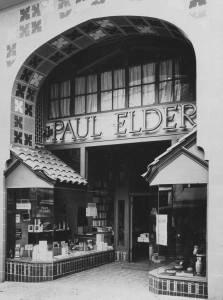
On 22 October 1921, after twelve years on Grant St., Elder moved his bookstore to 239 Post, across the street from where the 1898 store had been. The new store offered several advantages, including larger sales areas, plus a gallery and lecture hall. As an added bonus, Elder was now across the street from Gump’s, a family-owned, one-of-a-kind store with an international reputation. Paul Elder & Company would remain at this location for twenty-seven years, longer than any other site.
At first glance, one is puzzled how Post St. store could have more room than Grant St., as the building is much smaller. The answer is that architects Bernard Maybeck and C. C. Dakin incorporated sections of two buildings on Maiden Lane (numbers 134 and 140), whose rear walls adjoined the rear walls of 239 Post. It’s unclear whether Elder occupied the entirety of the two Maiden Lane buildings, or whether there was a street entrance into the bookstore from Maiden Lane.
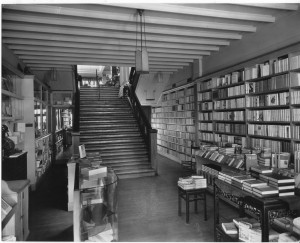
One of the benefits of hiring Bernard Maybeck for each successive bookstore was that Maybeck was able to incorporate architectural elements of the old stores into the new one. When the Grant St store opened in 1909, many furnishings were brought over from the 1906 Van Ness store: Arts & Crafts light fixtures, medieval chandeliers, stout wooden tables and bookcases. Likewise, when the company moved to Post St., the chandeliers and bookcases also moved, as well as the gothic openwork screens that Maybeck had designed for Grant St.
None of this was visible when a customer entered the store. Immediately inside the Post St. entrance was stationery and modern fiction. Upon climbing the stairs, however, a beautiful landing appeared, decorated with pottery and Asian hanging scrolls. From here, most customers could continue through a beautiful archway into the main book room. The archway was a clever way of masking the transition from the Post St. building to one of the Maiden Lane buildings. The main book room was divided into several sections, including the bargain alcove and fine bindings.

Passing through a smaller archway, one arrived at the “Paul Elder Gallery,” a lecture hall and performance space. There had been a gallery at Grant St., but it was much smaller. Elder made excellent use of this new, larger, gallery: over one hundred artists held exhibitions here, and there were frequent readings by featured authors. There were also music concerts, including performances by his three children, who were all talented musicians. His youngest son, Paul Elder Jr., considered becoming a professional cellist, but in the early 1930s decided to enter his father’s book trade instead, and eventually became proprietor when Paul Sr. retired in the early 1940s.
Back at the stairway landing, one could climb a short staircase in the other direction, back towards Post St., to reach the art room. Elder still thought of himself as both a bookseller and an art dealer. Although in 1921 the Arts & Crafts Movement was beginning to fade, soon to be overwhelmed by Art Deco, here at Paul Elder & Company there was still plenty of quality Arts & Crafts artwork for sale.
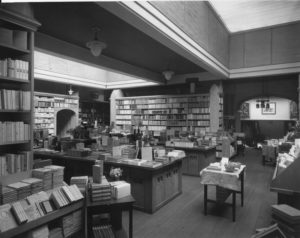
The 239 Post building survives and is currently a Graff jewelry store (now numbered 237 Post), but it has been remodeled multiple times and is nothing like it was during Elder’s time. It is no longer connected to the two buildings on Maiden Lane. Indeed, after Paul Elder & Company moved to Sutter & Stockton in 1948, the building at 140 Maiden Lane became quite famous: it was remodeled by none other than Frank Lloyd Wright. Originally known as the V.C. Morris Gift Shop, it is now ISAIA men’s wear. It is the only Frank Lloyd Wright building in San Francisco, and it’s full of curved designs such as a bricked archway, a spiral ramp, and a bubbled glass ceiling. Wright used the ramp as a prototype for his famous circular ramp at the 1952 Solomon R. Guggenheim Museum in New York City.1“Inside the only Frank Lloyd Wright building in San Francisco,” by Tessa McLean, 10 Apr 2023, https://www.sfgate.com/sfhistory/article/frank-lloyd-wright-building-san-francisco-vcmorris-14830042.php

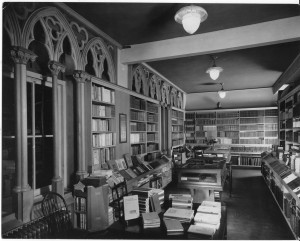
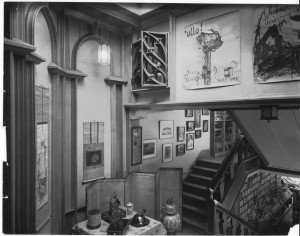
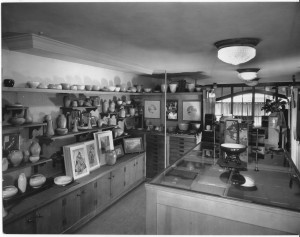
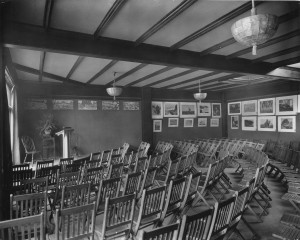
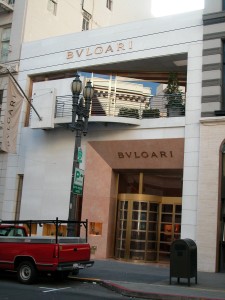
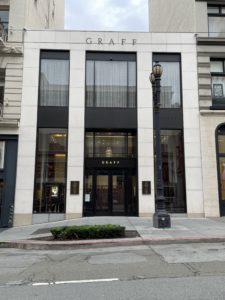
- 1“Inside the only Frank Lloyd Wright building in San Francisco,” by Tessa McLean, 10 Apr 2023, https://www.sfgate.com/sfhistory/article/frank-lloyd-wright-building-san-francisco-vcmorris-14830042.php
1 thought on “239 Post (1921-1948)”
Comments are closed.